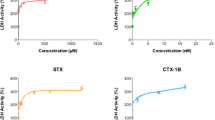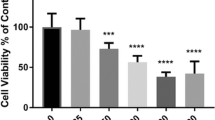Abstract
The sensitive and specific biochemical indicators for assessing chemical-induced neurotoxic insults in cell culture models have not been sufficiently explored. This study was designed to assess the usefulness of glia-specific beta-S100 protein and neuron-specific enolase (NSE) as indices of in vitro neurotoxicity of heavy metals. Glioma C6 and neuroblastoma N18TG-2 cells were grown in Dulbecco's modified Eagle's medium containing various concentrations of mercuric chloride (HgCl2) or cadmium chloride (CdCl2) for 5 days. Toxic response patterns of the neurospecific endpoints (beta-S100 and NSE), which were monitored with enzyme immunoassays, were compared with those of the non-neurospecific endpoints such as cell viability, total cellular protein, lactate dehydrogenase (LDH) activity, and cumulative glucose consumption in the two cell lines. Both HgCl2 and CdCl2 produced dose-dependent inhibition of neurospecific endpoints and non-specific endpoints. However, by ranking the EC50 values (effective concentration producing half-maximal inhibition) for various endpoints, the lowest values were found for beta-S100 in C6 cells, and for NSE in N18TG-2 cells. In lower and intermediate concentrations, the inhibitory effects of the heavy metals on the content of beta-S100 and NSE occurred in the absence of any detectable effect on intracellular LDH activity, and independently of total cellular protein inhibition. The sensitive and excess responses of the neurospecific endpoints relative to that of the non-specific endpoints may reflect the specific neurotoxic insults of the heavy metals on the cultured cells. The highly sensitive and nerve cell-specific changes of the two marker proteins after in vitro treatments with HgCl2 and CdCl2 indicate their usefulness as indicators of in vitro assessment of neurotoxicity.
Similar content being viewed by others
References
Amano T, Hamprecht B, Kemper W (1974) High activity of choline acetyltransferase induced in neuroblastoma × glioma hybrid cells. Exp Cell Res 85: 399–408
Bradford MM (1976) A rapid and sensitive method for the quantitation of microgram quantities of protein utilizing the principle of protein-dye binding. Anal Biochem 72: 248–254
Chao ES, Dunbar D, Kaminsky LS (1988) Intracellular lactate dehydrogenase concentration as an index of cytotoxicity in rat hepatocyte primary culture. Cell Biol Toxicol 4: 1–11
Cicero TJ, Cowan W, Moore BW, Suntzeff V (1970) The cellular localization of the two brain specific proteins, S-100 and 14-3-2. Brain Res 18: 25–31
Clementi F, Cabrini D, Gotti C, Fornasari D, Sher E (1987) A human neuroblastoma cell line for neurotoxicity testing in vitro: effects of heavy metals. In: Shahar A, Goldberg AM (eds) Model systems in neurotoxicology: alternative approach to animal testing. Alan R. Liss, Inc, NY, pp 137–149
Ekwall B (1983) Screening of toxic compounds in mammalian cell cultures. Ann NY Acad Sci 407: 64–77
Goyer RA (1991) Toxic effects of metals. In: Amdur MO et al. (eds). Casarett and Doull's Toxicology, 4th edition. Pergamon Press, NY, pp 623–680
Higashida H, Sano M, Kato K (1985) Forskolin induction of S-100 protein in glioma and hybrid cells. J Cell Physiol 122: 39–44
Huang J, Asaeda N, Takeuchi Y, Shibata E, Hisanaga N, Ono Y, Kato K (1992 a) Dose dependent effects of chronic exposure to toluene on neuronal and glial cell marker proteins in the central nervous system of rats. Br J Ind Med 49: 282–286
Huang J, Shibata E, Kato K, Asaeda N, Takeuchi Y (1992 b) Chronic exposure to n-hexane induces changes in nerve specific marker proteins in the distal peripheral nerve of the rat. Hum Exp Toxicol 11: 323–327
Huang J, Shibata E, Kato K, Asaeda N, Takeuchi Y (1993) Nerve-specific marker proteins as indicators of organic solvent neurotoxicity. Environ Res (in press)
Kato K, Higashida H, Umeda Y, Suzuki F, Tanaka T (1981 a) Regulation of neuron-specific enolase in NG108-15 hybrid cells and C6BU-1 glioma cells. Biochim Biophys Acta 660: 30–35
Kato K, Suzuki F, Umeda Y (1981 b) Highly sensitive immunoassay for three forms of rat brain enolase. J Neurochem 36: 793–797
Kato K, Nakajima T, Ishiguro Y, Matsutani T (1982) Sensitive enzyme immunoassay for S-100 protein: determination in human cerebrospinal fluid. Biomed Res 3: 24–28
Kung MP, Kostyniak PJ, Olson JR, Sansone FM, Nickerson PA, Malone MA, Ziembiec N, Roth JA (1989). Cell specific enzyme markers as indicators of neurotoxicity: effects of acute exposure to methylmercury. Neurotoxicology 10: 41–52
Labourdette G, Marks A (1975) Synthesis of S-100 proteins in monolayer cultures of glial cells. Eur J Biochem 58: 73–79
Marangos PJ, Goodwin FK, Parma A, Lauter C, Trams E (1978) Neuron specific protein (NSP) in neuroblastoma cells: relation to differentiation. Brain Res 145: 49–58
Minna J, Galzer D, Nirenberg M (1972) Genetic dissection of neural properties using somatic cell hybrids. Nature New Biol 235: 225–231
Nostrandt AC, Ehrich M (1992) Development of a model cell culture system in which to study early effects of neuropathy-inducing organophosphorus esters. Toxicol Lett 60: 107–114
O'Callaghan JP (1992) Assessment of neurotoxicity using assays of neuron- and glia-localized proteins: chronology and critique. In: Tilson H, Mitchell C (eds) Neurotoxicology. Raven Press, NY, pp 83–100
Prasad KN (1982) Tissue culture model to study the mechanism of the effect of heavy metals on nerve tissue. In: Prasad KN, Vernadakis A (eds) Mechanism of actions of neurotoxic substances. Raven Press, NY, pp 67–94
Saifer A, Gerstenfeld S (1958) The photometric microdetermination of blood glucose with glucose oxidase. J Lab Clin Med 51: 448–453
Sano M, Kato K, Seto-Ohshima A, Mizutani A (1984) Immunocytochemical localization of S-100 protein and calmodulin in C6 glioma cells. Acta Histochem Cytochem 17: 251–258
Schmechel D, Marangos PJ, Zis AP, Brightman M, Goodwin FK (1978) Brain enolases as specific markers of neuronal and glial cells. Science 199: 313–315
Schlier BK (1982) Nervous system cultures as toxicologic test systems. In: Mitchell CL (ed) Nervous system toxicology. Raven Press, NY, pp 337–348
Seliefreund RH, Barger SW, Pledger WJ, VanEldik LJ (1991) Neurotrophic protein S100 stimulates glial cell proliferation. Proc Natl Acad Sci USA 88: 3554–3558
Shain W, Bush B, Seegal R (1991). Neurotoxicity of polychlorinated biphenyls: structure-activity relationship of individual congeners. Toxicol Appl Pharmacol 111: 33–42
Suzuki F, Kato K, Kato T, Ogasawara N (1987) S-100 protein in clonal astroglioma cells is released by adrenocorticotropic hormone and corticotropin-like intermediate-lobe peptide. J Neurochem 49: 1557–1563
Veronesi B (1992) In vitro screening batteries for neurotoxicants. Neurotoxicology 13: 185–196
Yankner BA, Dawes JR, Fisher S, Villa-Komaroff L, Oster-Granite ML, Neve RL (1989). Neurotoxicity of a fragment of the amyloid precursor associated with Alzheimer's disease. Science 245: 417–420
Author information
Authors and Affiliations
Rights and permissions
About this article
Cite this article
Huang, J., Tanii, H., Kato, K. et al. Neuron and glial cell marker proteins as indicators of heavy metal-induced neurotoxicity in neuroblastoma and glioma cell lines. Arch Toxicol 67, 491–496 (1993). https://doi.org/10.1007/BF01969920
Received:
Accepted:
Issue Date:
DOI: https://doi.org/10.1007/BF01969920




